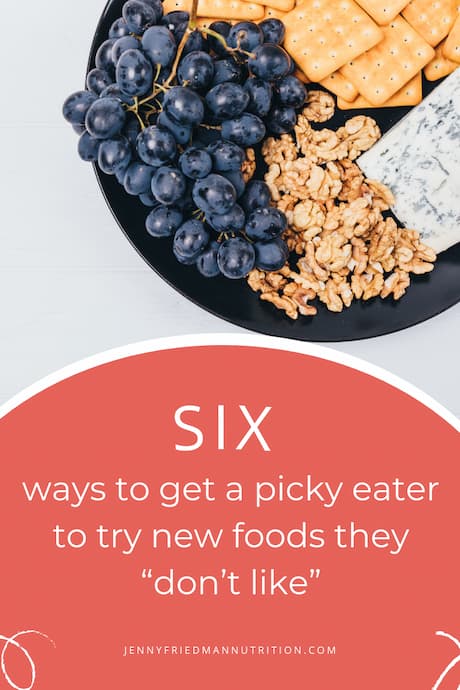If your picky child tries a new food and doesn’t like it, how do you get them to try again?
“I don’t like it” is a common refrain from picky eaters. Often you’ll hear this before they even try a new food. “I don’t like it” becomes a phrase that they use to avoid tasting.
Sometimes “I don’t like it” is also a knee-jerk reaction after a picky eater tries a new food.
Many parents struggle to get their picky eaters to try new foods after they’ve already tasted them and declared that they don’t like it.
The good thing is that “I don’t like it” is not a permanent decision and there are ways that you can help your child try new foods again, even if they said they don’t like them.

This article covers:
- How to prepare a child for what it’s like to taste a new food
- Why multiple exposures are important when tasting new foods
- How taste buds change
- Strategies to help a picky eater to try a new food again after they’ve said they don’t like it
- How to know when a child really doesn’t like a new food or just needs more time
How to Get a Child to Try a New Food Again If They “Didn’t Like It” at First
Prepare Them For What It’s Like to Taste a New Food
Even before your child takes a first taste, when you’re just working on the idea of diet expansion and trying new foods, start to prepare them for what the journey might look like and work to instill a growth mindset.
Learning to Enjoy New Foods Takes Time
Set their expectation that it might take time for them to like a new food.
Research suggests that young children without eating challenges need anywhere from five to 15 exposures of a new food before accepting it and that increased exposure increases their preference.
Exposure is extremely important in helping picky eaters try new foods. It’s important to plant the seed that learning to eat and enjoy new foods can take time and might not be a straightforward journey. There is no magic number for how many exposures your child will need. You don’t want to set them up with unrealistic expectations. Instead, reinforce that it is important to try new foods multiple times when they feel ready.
When your child tries a new food and immediately responds with distaste, you can reflect back to your child that they don’t seem to like it yet.
Taste Buds and Our Opinions Can Change
Our bodies are always growing and changing. That includes our minds and opinions. Just because your child didn’t care for something once or in the past, it doesn’t mean that they one day won’t enjoy it. Help them learn to be open to the possibility that they can one day like something new.
When Your Child Tastes Something New and “Doesn’t Like It”
Distinguish Between Truly Disliking and Having a Big Initial Reaction
Your child won’t like every single food. That’s okay. As your child begins to taste new foods it can be helpful to identify when something is just new and they don’t like it yet and then they truly do not care for something. As they try new foods and continue to eat ones they do like, identify the qualities that they enjoy and the ones that they don’t care for. Use this information about their preferences when they’re tasting new foods to try to distinguish true dislike from needing more time.
Let Your Child Prepare It
Cooking provides a sense of investment that can increase a child’s interest in eating and research tells us that kids who cook are kids who eat. Cooking is a valuable experience for extreme picky eaters because it puts them in control. When they’re the chef they get to make every decision about how their food looks and tastes. Remind them that they can “fix” the food to make it more appealing.
Change How It Is Served or Prepared
Ask for their input. Would they rather it be big or small, cut or whole? Sauce on the side or on top? Remind them that something as simple as the way a food is cut can change how it tastes.
Recap
Many parents struggle to get their picky eater to try new foods after they’ve already tasted them and said that they don’t like it. It is helpful to prepare picky eaters for what tasting new foods is like even before they’re read to try new foods. Then, once your child does taste a new food, you can make tasting again easier by getting them involved in food prep and learning more about their preferences.
Next Steps
Are you still feeling stuck? You don’t have to work on this alone. You can get personalized support to help your child try new foods and expand their diets in my coaching program.



0 Comments